|
Stay tuned for additional posts answering questions posed by the participants of the Harriet Beecher Stowe House Community Connection Facebook group. CLICK HERE to join the group and submit your own questions to our volunteer team! Today's question is answered by docent Nicholas Andreadis. 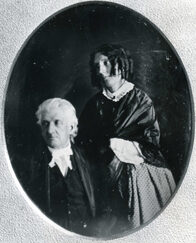 Harriet Beecher Stowe and her father Lyman Beecher (photo from Harriet Beecher Stowe Center) Harriet Beecher Stowe and her father Lyman Beecher (photo from Harriet Beecher Stowe Center) Question: How did Harriet and her father get along since they seem to be on opposite sides on how to accomplish abolition? In the nineteenth century no issue was more divisive within American families than slavery; what should be done about the institution and more specifically who should fight for it or against it. Side-stepped by the framers of the Constitution, it fell to American families to resolve the great questions. This was certainly a topic in the hearts and minds of the Beecher family; no more so than Harriet and her father, Lyman. It was natural that Harriet would first look to her father (along with her sister Catharine and her Aunt Harriet) for guidance and perspective. Like many important men of the 1820s, Lyman Beecher supported the American Colonization Society’s program of helping free Blacks emigrate to West Africa. Colonization proved over time to be an ineffectual method for calming the turbulent waters of slavery. Milton Rugoff tells us that William Lloyd Garrison, editor of the anti-slavery newspaper The Liberator, became a member of Beecher’s congregation in Boston. Garrison, he writes, was soon urging Beecher toward the abolitionist stance. But Beecher was not moved easily and like many ministers of the time he argued that even the Bible had at times vacillated on the issue of slavery. He allowed that slavery was evil but appealed to God’s righteousness to destroy the institution. One might conclude that Lyman “walked the fence” between what was morally right and what was pragmatic. His stances during the Lane Debates provide further evidence for this. He oscillated between support for the students and submission to the wishes of the school’s trustees. Harriet by nature and disposition was a quiet, introspective thinker and she brought these characteristics to her evolving attitude regarding slavery. She developed her own philosophical, moral and spiritual touchstones ultimately becoming a fierce abolitionist.
Harriet recalls from her childhood overhearing discussion among her elders over the great debate of that time, the Missouri Compromise. Only later would she realize that no compromise would settle the greatest issue facing America in the Nineteenth century. She was a witness to the famous Lane Debates organized in 1834 by the firebrand, Theodore Weld. And certainly, she was influenced by her brother Edward’s Narrative of Riots at Alton (Illinois) describing the brutal killing of abolitionist minister and editor Reverend Elijah Lovejoy. She was later Influenced by Angelina Grimke and began to view abolition and women’s rights as linked issues. It was the death of her son Charley to cholera in 1849 and the passage of the 1850 Fugitive Slave Act that drove her to write Uncle Tom’s Cabin. Harriet carefully listened to the arguments within her community and the experiences of free and fugitive slaves choosing the written word to express her contempt for slavery, often doing so anonymously to avoid drawing unpleasant attention to her father. Though later she veered away from her father on the issue of abolition and abandoned the strict principles of Calvinism, I found no evidence that she held any antipathy toward him. Rugoff offers that in her autobiography Harriet paid tribute to her father in his prime. She was to my mind and by most accounts a loyal daughter. Source material for this essay: The Beechers: An American Family in the Nineteenth Century by Milton Rugoff (1981) Harper and Rowe Harriet Beecher Stowe: A Life by Joan Hedrick (1994) Oxford University press About the author: Dr. Nicholas Andreadis is a docent at the Harriet Beecher Stowe House. He was a professor and dean at Western Michigan University prior to moving to Cincinnati.
0 Comments
Stay tuned for additional posts answering questions posed by the participants of the Harriet Beecher Stowe House Community Connection Facebook group. CLICK HERE to join the group and submit your own questions to our volunteer team! Today's question is answered by docent and board member Frederick Warren. Question: How did Harriet Beecher Stowe learn to write a novel?
Growing up in Litchfield, Connecticut, Harriet became an avid reader. As the child of a Congregational minister she was steeped in the Bible. Though her father Lyman’s faith frowned on fiction, the Beecher family was introduced to Sir Walter Scott’s Ivanhoe and to Lord Byron’s poetry by Harriet’s uncle Samuel Foote, a sea captain fluent in French and Spanish, and the ban on novels was lifted. Harriet remembered discovering her father Lyman’s copy of Arabian Nights and being “transported to foreign lands.” Litchfield was a cultural center, boasting the first stand-alone law school in the U.S. and the country’s first important early school for women, Sarah Pierce’s Female Academy. Harriet entered there at the age of eight, four years earlier than the normal starting age. There she read classics of English literature from Milton, Dryden, and Fielding. She began writing weekly compositions at the age of nine, leading her father to observe that “Harriet is a great genius…She is as odd as she is intelligent and studious…” Just as important as her schooling in Harriet’s learning to write were the domestic literary efforts within the Beecher family. People entertained themselves with readings of essays and poems, and Harriet remembered her eldest sister Catharine often writing for the family. People also wrote letters, a skill that was taught at school, and they were often read aloud in the parlor. And formal literary clubs that met in people’s homes were popular. Harriet honed her powers of observation of character and her story-telling ability in this fashion. She then completed her formal education at Catharine’s academy for women in Hartford, where she began her journalism career by editing issues of the school newspaper. Harriet served her literary apprenticeship in Cincinnati, beginning in 1833 by writing a Primary Geography for Children for Catharine’s Western Female Institute in downtown Cincinnati. The book’s success, due to its personal voice and evocative descriptions, led to her invitation to join the Semi-Colon Club, a literary society that was sponsored by the very same uncle Samuel Foote who has so influenced her as a child. The members would contribute stories, essays, and sketches. Soon Harriet’s character sketch “Uncle Lot” had won the Western Monthly Magazine’s prize competition and was the first of many to be published. By 1843 she had published her first collection of such pieces, The Mayflower: Or, Sketches of Scenes and Characters Among the Descendants of the Pilgrims. She was well on the way to finding her literary voice that we know from Uncle Tom’s Cabin. Note: The source material for this brief essay is Harriet Beecher Stowe: A Life by Joan Hedrick (Oxford University Press 1994) and Crusader in Crinoline: the Life of Harriet Beecher Stowe by Forrest Wilson (J. B. Lippincott 1941). About the author: Frederick Warren is a docent at the Harriet Beecher Stowe House, as well as a tour guide for the Friends of Music Hall. He is a retired estimator for a book printing and binding firm in Cincinnati. There are many free ways to read and listen to Uncle Tom's Cabin. Here are a few:
E-books
Audio Books
Children's Edition
Stay tuned for additional posts about Harriet dealing with cholera and other questions posed by the participants of the Harriet Beecher Stowe House Community Connection Facebook group. CLICK HERE to join the group and submit your own questions to our volunteer team! Today's question is answered by docent Nicholas Andreadis. Question: How did HBS deal with the cholera epidemics?
It is noteworthy that the scourge of cholera bookends Harriet Beecher Stowe’s time in Cincinnati. By the time of her arrival in autumn 1832, the illness had reached Cincinnati, probably brought by people traveling along the Ohio River. She departs for the East following the 1849 epidemic that took her beloved son Samuel Charles Stowe, affectionately known as Charley. Charley was one of three thousand people who died in Cincinnati in the epidemic of 1849. Cholera is a disease spread via contaminated water and sewage, of which Cincinnati had a generous share due to its pig processing industry. It was greatly feared because it was so lethal, its cause unknown at the time and the common belief that it was a consequence of God’s anger with his Christian flock. Cholera struck close to Harriet. She grieved over the death of her friend Eliza Stowe, comforted Calvin and as we know, later became his wife. She herself displayed the symptoms in 1845. But without question it is the loss of young Charley that shaped her private and public expressions of grief. When Charley fell ill, Harriet wrote to her husband Calvin that she had little hope of his recovery. There was no medical intervention available at the time, and all Harriet could do was watch helplessly while her eighteen-month-old child was wracked by convulsions and lost all the fluids in his body. She writes: “Today is a rather dejecting day. I don't particularly feel like talking about it because my heart can barely take all the emotion of today. I am overwhelmed with confusion and sadness. Today my eighteen month old son died of Cholera. As I sat cradling him in my arms for the last minutes, the last breath of his short life, I could see the life being sucked right out of his small, frail body. His eyes were glassy and his skin was as dry as the dust on my boots. It felt as if the life was being sucked out of me the longer I sat there staring into his blank expression. He seemed so disconnected; So helpless. That was one of the hardest things I have ever done. No way to help, all I could do was sit there and accept that my child was breathing his last breaths. I referred to him as my sunshine child. At only one year and six months he lit up my day like the sun fills the sky with light and gives everyone a feeling of warmth. I will never forget my baby boy. Having experienced losing someone so close to me I can sympathize with all the poor, powerless slaves at the unjust auctions. You will always be in my heart Samuel Charles Stowe.” She later wrote that there were circumstances of such bitterness in the manner of Charley's death that she didn't think she could ever be reconciled for it unless his death allowed her to do some great good to others. Losing Charley made her understand what a slave woman felt when her child was taken away at the auction block. Harriet poured her grief onto the pages of Uncle Tom’s Cabin. Her description of the evil of slavery are vividly displayed in a prose style that touched the hearts of many Americans, particularly those in the North. As Joan Hedrick writes, “Harriet Beecher Stowe had a profound effect on nineteenth-century culture and politics, not because her ideas were original, but because they were common.” Note: The source material for most of the information contained within this brief essay is Harriet Beecher Stowe: A life by Joan Hedrick published 1994 by Oxford University press About the author: Dr. Nicholas Andreadis is a docent at the Harriet Beecher Stowe House. He was a professor and dean at Western Michigan University prior to moving to Cincinnati. Dr. John Getz from Xavier University is leading us on a tour of Harriet's "Literary Neighborhood"--authors and work that interacted with her own life and work, even though they were often geographically far apart. CLICK HERE for the full series. 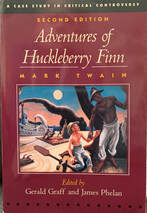 Harriet Beecher Stowe and Mark Twain were friends, and he literally lived in her neighborhood, in fact, next door to her in Hartford, CT, from 1874 to 1891. They shared jokes and a passion for social justice. If you read Twain’s classic Huckleberry Finn in grade school or high school, give it another try from your later perspective. You may find that the parts you laughed out loud at back then are less interesting and that some parts you skipped over speak to you more today. 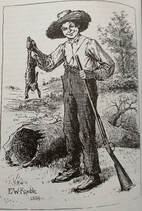 If Huckleberry Finn seems uneven, remember that its author struggled to write it in fits and starts from 1876 to 1885. Remember too that slavery had been abolished for over a decade when he began the project, so he never saw it as an abolitionist novel though it’s set in the 1840s. The targets of Twain’s satire are many, but see if you can find examples of his concern about postwar attempts to glamorize the antebellum South and the Lost Cause of the Confederacy. Try reading some of this book aloud. That will help if the dialogue seems confusing. You’ll also hear Huck’s voice, one of the most original and enduring of Twain’s creations.
Huckleberry Finn was controversial when published in 1885 and remains so today. Recent objections focus on the characters’ use of the N-word and on the characterization of Jim and his relationship with Huck. You can read Adventures of Huckleberry Finn free online through Project Gutenberg. If you read or reread even part of it, let us know your reactions. About the author: Dr. John Getz, Professor Emeritus, Xavier University, retired in 2017 after teaching English there for 45 years. He specializes in American literature, especially nineteenth century, as well as the intersections of literature and peace studies. He has written articles on a variety of authors including Edith Wharton, Sherwood Anderson, and Ursula Le Guin. He appears in the documentary film Becoming Harriet Beecher Stowe, scheduled for release in spring 2020 by Fourth Wall Films.  April at the Harriet Beecher Stowe House looks a bit different this year. While the new visitor ramp and entrance are complete and the flowers are blooming, our doors are closed to make sure everyone is staying home and staying safe. We will re-open according to the direction of the Ohio History Connection and the governor. Although we are closed to visitors, we have not stopped working toward our mission. We conducted our first Year of the Woman discussion this week via Zoom and enjoyed great success with that format. We have been posting daily content, videos, and information via our Facebook group – Harriet Beecher Stowe House Community Connection – along with Instagram and Twitter. We are looking at other ways to stay engaged and connected to our wonderful community of history buffs and social reform advocates. We are also continuing plans for our Isabella Beecher Hooker exhibit to open this summer. Financial constraints are being felt across the board. We recognize that and we are certainly not immune. I invite you to donate to the Friends of Harriet Beecher Stowe House if that is within your means. You can mail a check to: 2950 Gilbert Avenue, Cincinnati, OH, 45206 or simply use the donate button on our website. Thank you for being an ambassador for Harriet and her message of freedom and humanity. Christina Hartlieb
|
Archives
March 2025
Categories
All
|
|

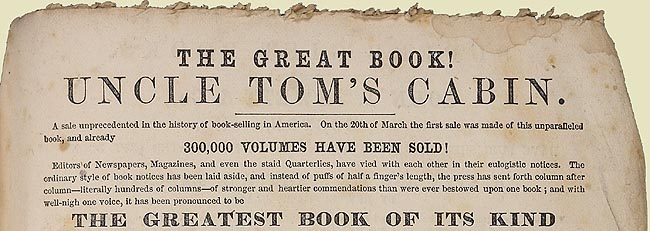

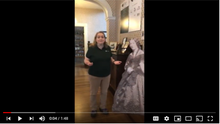

 RSS Feed
RSS Feed